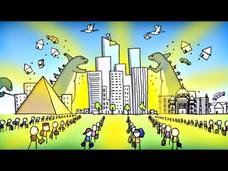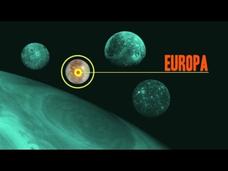TED-Ed
What Would It Be like to Live on the Moon?
Will the next generation have the option of living on the moon? Discover the challenges and adjustments required to live in such a harsh environment with a short video that describes some of the obstacles scientists must overcome in...
TED-Ed
Science Can Answer Moral Questions
Can questions of morality, good and evil, right and wrong, and/or what is worth living and dying for...be answered by science? Author Sam Harris presents a strong case for the need for a universal conception of human values. He argues...
Khan Academy
First Living Things on Land Clarification, Cosmology and Astronomy
Sal clarifies concepts covered in the Khan Academy video on Biodiversity in the Phanerozoic Eon. He explains the types of animals and plants that were the first life forms on land. Additionally, he describes what these organisms would...
Crash Course Kids
Living Things Change
What happens to organisms when the environment around them changes? This is the focus of a video that describes how living things must adapt to their ever-changing environment.
Veritasium
Why Do Venomous Animals Live In Warm Climates?
Why do warm, tropical environments seem to be the perfect place to find so many of the world's most venomous animals? Explore several theories in an interesting video. The narrator differentiates between venomous and poisonous, describes...
SciShow
How to Live Forever? Be a Jellyfish
The turritopsis dohrnii, or immortal jellyfish, are tiny, with adults measuring only 0.18 inches tall and wide. The narrator of this short video explores the immortal jellyfish and the importance of their unique and amazing lives. These...
Crash Course Kids
Big Changes in the Big Apple
How do living things change their environment? This is the focus of a video that describes how the building of communities and clearing of forests changes the types of living organisms that can thrive there.
Crash Course Kids
Big Changes in the Big Forest
What do animals and humans have in common? We both build homes that are suitable for our means of living, of course! This is the focus of a video that compares how humans and animals change the environment around them.
FuseSchool
Extinction of Species
Extinction: i's not just for dinosaurs! Young ecologists examine the alarming facts about the causes of mass extinctions by watching this engaging Fuse School Evolution video. Topics include previous extinction events, living fossils,...
Bozeman Science
Environmental Matter Exchange
Why did carbon marry hydrogen? They bonded well from the minute they met. Here is a video that focuses on the essential chemicals for life: water, carbon, nitrogen, and phosphorus. It relates each of these to macromolecules and the way...
Curated OER
Exploring Oceans: Great Barrier Reef
All aboard! Let's take a trip to the world's largest living structure, the Great Barrier Reef. Encompassing more than 1,200 miles of islands and reefs, it is considered one of the seven wonders of the natural world due to its...
California Academy of Science
What is the Environmental Impact of Feeding the World?
One in every seven people suffer from a lack of basic food. Our Hungry Planet introduces this complex issue in the second lesson of an interesting 13-part unit. It discusses the space needed to grow and raise food, the transportation of...
Crash Course
Pollution
An environmental science video covers natural and synthetic compounds and the impact they have on the environment. It includes carbon, nitrogen, phosphorous, cyanide, mercury, sulfur, nitrogen dioxide, and endocrine disruptions.
Scholastic
Study Jams! Plant Adaptations
Mia video chats with Sam from Hawaii! They talk about plant adaptations that allow them to live in particular environments. Examples include the flexible stems and leaves, or floating seeds and flowers of aquatic plants. The adaptive...
Deep Look
Pygmy Seahorses: Masters of Camouflage
Watch as pygmy seahorses become one with their environment. The life of a pygmy seahorse begins and ends on a branch of coral. An interesting video lesson explores how camouflage protects this delicate species and how they adapt when...
Crash Course
Derivatives
Physics and math are closely associated in the science community. High schoolers use information in the video to determine how derivatives and calculus help them understand our local environment. They complete problems that relate to...
PBS
That Time Oxygen Almost Killed Everything
Oxygen keeps us alive, but did you ever consider how Earth found the right balance? Eons produced this video as part of a larger series that explores when Earth contained very little oxygen and green oceans ruled the planet. Viewers see...
MinuteEarth
How to Build a Better City
Think you're helping the environment by living in the suburbs rather than the city? Think again! Young scientists examine the effects of urban sprawl in a video that compares the environmental advantages of closely packed city life to...
SciShow
Europa
"Europa’s ocean is considered to be one of the most promising places that could potentially harbor life in the solar system,” said Geoff Yoder, with NASA’s Science Mission Directorate. Show a video that shares four surprising facts...
Sesame Street
Cameron Diaz: Habitat
Cameron defines that word habitat with all of her animal friends. Viewers will learn that a habitat is where an animal gets food, finds water and also shelter. It is the place where animals live.
MinuteEarth
Which Bear Is Best?
Is it survival of the fittest, or just luck? The video focuses on two examples, bears and ferrets, living in North America and Asia. It explains which animals are thriving and which are in danger of going extinct and the reasons.
Nature League
Can Complex Life Evolve Without Oxygen? - From A to B
Can complex life develop in an oxygen-depleted environment? Scholars listen to a discussion of the topic between two people: one interested in science without studying it and one working on a doctoral degree in science. The fourth video...
Deep Look
Why Jellyfish Float Like a Butterfly—And Sting Like a Bee
Jellyfish predate dinosaurs by 400 million years. The video explains how jellyfish without a heart, blood, or a brain have survived longer than most other species. It details two of their tricks for adapting and finding prey as their...
Bill Nye
Bill Nye The Science Guy on Evolution
Mr. Nye explains that living organisms change slowly over time. He uses the example of how humans have changed the environment for fish and emphasizes that fish cannot adapt as quickly as we are changing their habitats. A silly sci-fi...























